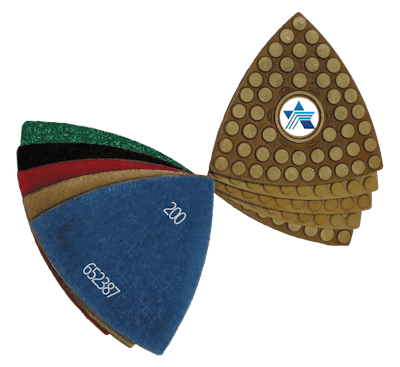
As consumer demand for polished concrete has increased, so has the need for high quality finishes – even in the corners, edges, stairs and door jambs, places that had been ignored before the traditionally industrial flooring got hot.
The tight spaces presented a problem to contractors, who were left to jury-rig their equipment to finish the job right, often with sub-par results.
Customer demand prompted engineers at BORIDE Engineered Abrasives – creator of the Blue Star Diamond (BSD) abrasive – to develop a tool that was not only durable but could deliver a professional finish to hard-to-reach areas.
The BSD Corner Tool was born.
“Bedrock [Contractor Supplies and Rental] had several contractors that were interested in a product like this,” says Mark Listermann, sales and accounts manager for BORIDE’s floor finishing products. “We put together a prototype; the contractors liked the way the diamonds cut and the quality finish.”
The launch of the BSD Corner Tool filled a gap in the floor finishing industry, says Matt Tetrault, operations manager for the Rhode Island-based Bedrock, which services contractors on the East Coast.
“Prior to the corner tool, [contractors] would be cutting out resin pads or using electroplated,” Tetrault explains. “They’d literally be cutting and fitting their own tooling. It was a Band-Aid for the problem. So now there’s finally a solution.”
The feedback from Tetrault’s customers was that they were saving time and happy with the result, he said.
“The corner tool stays relatively cool and keeps them cutting longer,” notes Tetrault, whose employees run deliveries from Maine to Long Island, N.Y. and ship nationwide. “The feedback we’re getting is they’re happy with the speed. It gives them fewer problems. There isn’t much on the market for corners so it’s innovative in that way.”
Tetrault says he has noticed contractors that traditionally wouldn’t touch concrete floor finishing are now coming on board because of better education and consumer demand.
“This is an industry that’s probably doubled in growth because architects and contractors are understanding the product and using it,” he says. “Consumers are saying they want polished concrete and the contractor is now able to give them a better finished product with tools like the corner tool.”
Corners, edges, stairs and door jambs can present a tough challenge, especially on a project where the floor is anything but an afterthought, says Meghan Littlefield, vice president of Polished Concrete of New England in Sanford, Maine.
“I think [polished concrete] absolutely can be an art form,” says Littlefield, whose contractors finish up to four projects a week. “There’s a broad range from the industrial side of concrete polishing – which is utilitarian – all the way up to high-end fabrications with color, which is more on the artistic side.”
Polishing a concrete floor takes skill, especially in decorative application, Littlefield says.
“In general, edges – and corners especially – in a decorative application are critical aesthetically. If you do not do a good job, it will stand out and ruin the aesthetics of the job,” she explains. “You’ll have an unhappy customer and won’t get paid.”
After working with BORIDE engineers on the corner tool, Littlefield says that switching to the triangular-shaped tool helped simplify the tooling and keep the polishing process consistent.
“The tool is critical for getting into the corners so you can feather out into the floor and achieve a consistent look,” she says. “A lot of contractors will try to get in there with a cup wheel, but you’ll always miss that corner and that will stand out visually.”
The feedback from the field has been “good,” Littlefield notes.
“[The corner tools] work well; they last a long time,” she says. “We love the rest of the BORIDE line; it’s helpful to be utilizing the same tool or bond whether you’re doing the corners, the edges or you’re feathering things out.”
The BSD Corner Tool is hand-crafted several at a time at BORIDE’s Traverse City, Mich. headquarters.
In the plant, an operator layers the company’s proprietary diamond grit mixture over a mesh backing, which is placed on a resin core in a steel mold. The molds are pressed, then baked in a specially designed oven.
The bond technology that BORIDE developed is known for its superb finish on soft to very hard surfaces and for its ability to withstand aggressive grinding, wet or dry.
By using the company’s Blue Star Diamond formulation, the corner tool helps save users time and money, says Carla Nickodemus, business development and product manager for BORIDE’s floor finishing products.
“The Blue Star Diamond line is the result of more than 40 years of research and development in abrasive products,” she explains. “This means corner tool users will get an outstanding concrete finish in fewer steps – and therefore at a lower cost – than with traditional finishing methods.”
The pad’s design is compatible with most oscillating multi-tools, including Fein, DeWalt, Dremel and Makita, and needs only occasional misting to keep the heat in check. The corner tools are sold in packs of two, ranging from 30 to 400 grit. A five-quantity starter pack that includes the full range of grits is also available.
Sold as a private label product through distributors in the U.S., Canada and Europe, the sales numbers so far are positive, Nickodemus reports.
“After the initial launch in August 2017, the first six months of 2018 show the corner tool increasing sales by five percent,” she notes.
And it’s no wonder. Beyond its innovative product line and responsive customer service, BORIDE’s team has “got your back,” says Tetrault.
“They’ve got a great group, they are smart … I’ve got not a complaint about those guys,” he says. “Anything you need, they’ve got your back.”


















